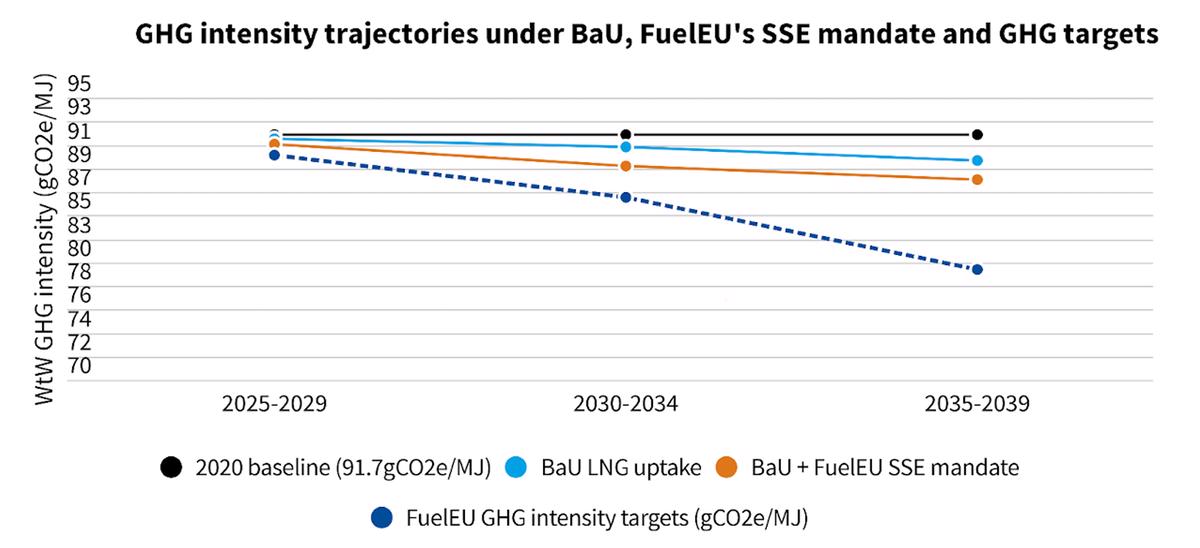Proposed 6% GHG intensity reduction target for shipping ‘unfit’ for 55 - T&E
The EU needs to step up its ambitions on greenhouse gas (GHG) emission cuts, Transport & Environment (T&E) has urged ahead of the European Parliament plenary meeting that starts today.

PHOTO: European Parliament headquarter in Strasbourg, France. Getty Images
T&E is Europe’s umbrella organisation for sustainable transport non-governmental organisations, reported in January that the EU's shipping industry emitted nearly 130 million mt/year of CO2, making up roughly 4% of the bloc's total emissions.
To reduce this footprint of CO2 and other GHGs, the Transport Committee of the European Parliament tabled a draft of a 'negotiating mandate' setting goals to adopt stricter emission targets than those included in European Commission’s earlier FuelEU Maritime proposal.
FuelEU Maritime is the shipping part of the EU's 'Fit for 55' strategy, which sets out to cut the EU's net GHG emissions by 55% by 2030 compared to 1990 levels.
The European Parliament Transport Committee's proposed amendments to the yearly average GHG intensity reduction targets for energy used on board ships (compared to the European Commission's earlier proposal):
- 2% from 2025 (2%)
- 6% from 2030 (6%)
- 20% from 2035 (13%)
- 38% from 2040 (26%)
- 64% from 2045 (59%)
- 80% from 2050 (75%)
If approved, these targets will apply to ships above a 5,000 gross tonnes (GT), to all energy used onboard ships in or between EU ports, and to 50% of energy used on voyages where the departure or arrival port is outside of the EU.
The European Commission will also consider decreasing the threshold from 5,000 GT to 400 GT.
The negotiating mandate will be up for discussion and a vote at European Parliament’s plenary sitting on 17-20 October in Strasbourg.
 CHART: T&E research has found that FuelEU Maritime will achieve negligible GHG emission reductions until 2040 in business-as-usual (BoU) scenarios with either LNG update or shore-side electricity on their own. T&E
CHART: T&E research has found that FuelEU Maritime will achieve negligible GHG emission reductions until 2040 in business-as-usual (BoU) scenarios with either LNG update or shore-side electricity on their own. T&E
Seeking decarbonisation? Rethink your targets
Although these targets clearly indicate a tougher stance for the years after 2035, T&E says a 6% reduction in GHG intensity will fall short of meeting the deadline set by the UN's Intergovernmental Panel on Climate Change IPCC's to halve GHG emissions by 2030.
To "set the right direction", and to have a fair chance of full decarbonisation by the middle of the century, T&E suggests an overall GHG intensity reduction of 13% by 2030.
LNG in focus
The European Parliament's draft negotiating mandate defines GHG emissions as the release of carbon dioxide (CO2), methane (CH4) and nitrous oxides (N2O) into the atmosphere and calls for a comprehensive approach to promote the use of energy sources with a lower GHG footprint overall.
Regarding LNG, the MEPs point out that this fuel alternative must increasingly be decarbonised through blending with liquefied biomethane (bio-LNG) or renewable and low-carbon synthetic gaseous e-fuels.
Meanwhile, the MEPs left out a critical measure: to reducing onboard methane emissions from vessels – one of the biggest problems highlighted by climate and green shipping experts around the world.
Jutta Paulus and Silvia Sardone, members of the European Parliament's Environment, Public Health and Food Safety Committee, submitted a joint draft report in September, in which they called for for EU regulation to reduce methane emissions from the energy sector overall. But this has not been specifically addressed in the ‘negotiating mandate’ for maritime sector.
Time to power up hydrogen-based fuels
In addition to incremental GHG intensity reduction targets, MEPs have proposed to mandate companies that operate three or fewer ships above 5,000 GT to use at least 2% renewable fuels of non-biological origin (RFNBOs or hydrogen-based fuels). Another key proposal is for container ships and passenger ships docked at EU ports for more than two hours to use on-shore power.
They will also reward companies that decide to opt for these fuels through a so-called "multiplier of 2", meaning they will count twice as much toward lowering a company's average GHG intensity rating than bio-derived fuels.
According to the EU's renewable energy directive, biofuels must achieve a minimum 65% reduction in GHG emissions, whereas RFNBOs and recycled carbon fuels have a minimum emission-saving threshold of 70%.
“TRAN (transport) committee is suggesting only a sluggish start with a 2% sub-quota in 2030, and a provision exempting over half of shipping companies, when both NGOs and industry are calling for at least 6%,” T&E sustainable shipping officer Delphine Gozillon commented. T&E calls for a more ambitious "multiplier of 5" to “bridge the gap of cost of compliance for green e-fuels.”
Finally, T&E urges the European Commission to make data public on compliance with the emissions mandate, once it is voted into law. This would be similar to how the monitoring, reporting and verification (MRV) CO2 data on ships above 5,000 GT calling in EU ports is presented, and would ensure a transparent system, Gozillon said.
By Konica Bhatt
Please get in touch with comments or additional info to news@engine.online






